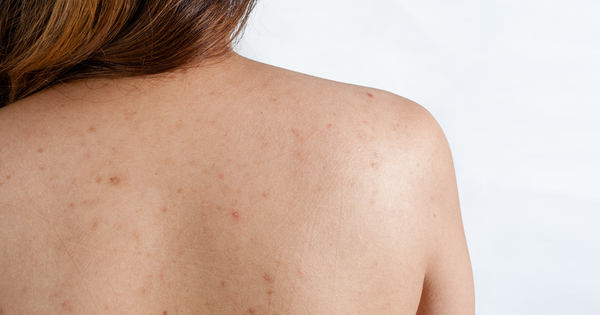Back acne treatment
Pimples that appear on the back are different from those that pop up on the face. The reason for these problems is the same: the pores become clogged with sebum, which leads to the growth of bacteria. Well, or you are too nervous, and the body reacts to stress in this way. But here you need to treat acne on your back a little differently, so do not rush to get creams and face masks.
Acne on the back is not only a cosmetic defect, but also a sign of a pathological process in the body. Therefore, the appearance of rashes must be taken seriously and seek medical help in time.
External causes
We are talking about cases where rashes are an inflammatory reaction of the skin to an unfavorable environment. Most often, this leads to

Patient education:
Insufficient hygiene. There are many sebaceous glands on the skin in the shoulder area. Sebum is an excellent breeding ground for various bacteria that cause acne. Someone produces less fat, someone more. And if you belong to the second category, it is important to approach back hygiene more carefully.
Aggressive cleansing. If you use washcloths, brushes, scrubs and actively rub your back with cleansers, you can injure the epidermis, damage your own lipid layer, destroy beneficial bacteria that live on the skin.
Taking hot baths, frequent visits to baths and saunas. Moisture and heat like fungi and bacteria, so rashes can become more. And swimming in not very clean water can lead to Folliculitis/MSD and Pseudomonas Folliculitis.
Synthetic clothing. If things made from natural fabrics remove moisture well and allow the skin to breathe, then synthetics often play the role of a kind of thermos. Due to poor ventilation, sweat is released more actively. It remains on the skin and, like fat, improves the well-being of microbes.
Too tight tight t-shirts and sweaters. They can literally rub dirt and sweat into your pores.
Loose hair. They share their own dirt and grease with the back skin. In addition, the ends of the hair irritate the skin, causing it to produce excess portions of fat.
Using the wrong cream or lotion. For example, an overly oily sunscreen can protect your back from UV rays, but it can also clog pores, increasing your risk of breakouts.
In fact, this is not a complete list of external causes. Scientists can not always identify the causes of the rash. This is due to the characteristics of each person and the fact that sometimes acne occurs for strange reasons.
What foods cause acne
One of the risk factors for acne is poor diet. Foods high in saturated fat have been shown to increase inflammation in the body, including an increased risk of acne and eczema. Sweets and simple carbohydrates also increase the likelihood of skin problems.
Internal causes
Genetics. Predisposition to acne is often inherited from parents.
Hormonal changes. Pimples on the back and shoulders for many occur in adolescence – this is due to the restructuring of the body. Acne in women can also be Acne. Causes/NHS is caused by hormonal fluctuations during menstruation and pregnancy, or increased levels of male hormones in polycystic ovary syndrome.
Stress. Emotional stress does not directly cause a rash. However, they can affect the hormonal background or the immune system, which, in turn, already provoke rashes. But the passion to comb and squeeze acne leads to an increase in the inflammatory response and the appearance of deeper elements, the appearance of scars.
Features of nutrition. Suspicion includes foods with a high glycemic index (you can find a list of them here) and milk.
How to treat acne on the back
Unfortunately, simple means do not always help. If you have adjusted your lifestyle, but the number of acne has not decreased in a month, be sure to consult a dermatologist. Rashes can be a sign not only of acne, but also of infectious diseases, such as syphilis.

The doctor will ask you in detail about your lifestyle and health, if necessary, ask you to take tests and prescribe treatment.
Healing creams and ointments. There are many drugs for external use. Some of them fight excessive sebum production, others effectively kill bacteria. Such products may contain both salicylic acid and benzoyl peroxide already mentioned, as well as azelaic acid, retinoids and antibiotics.
Tablets. They affect not only the skin, but also the entire body from the inside. These can be antibiotics, hormonal drugs (for example, birth control), isotretinoin (a bioactive form of vitamin A). It is important to remember here: such medicines can have quite serious side effects, so self-medication is unacceptable!
Chemical peels. Their main active ingredient is salicylic, glycolic or retinoic acid in varying concentrations. Peeling allows you to remove the affected top layer of the skin, even out its relief. It is used to combat minor rashes and post-acne.
Phototherapy. With the help of a special device that generates broadband pulsed light, the growth of bacteria is suppressed, and the number of acne is reduced. The effectiveness of the method has not been proven, additional studies are required. So while phototherapy is used as an auxiliary.
Mechanical and manual cleanings. They can reduce the appearance of blackheads, but damage the sebaceous glands and skin and often lead to scarring. So not recommended for everyone.
Steroid injections. They are done, for example, in cystic acne to quickly get rid of them and relieve pain. The method is effective, but there are side effects: at the injection sites, the skin may become thinner and lighter.
What therapy will be effective in your case, the doctor will tell you. Do not self-medicate, so as not to aggravate the situation.
